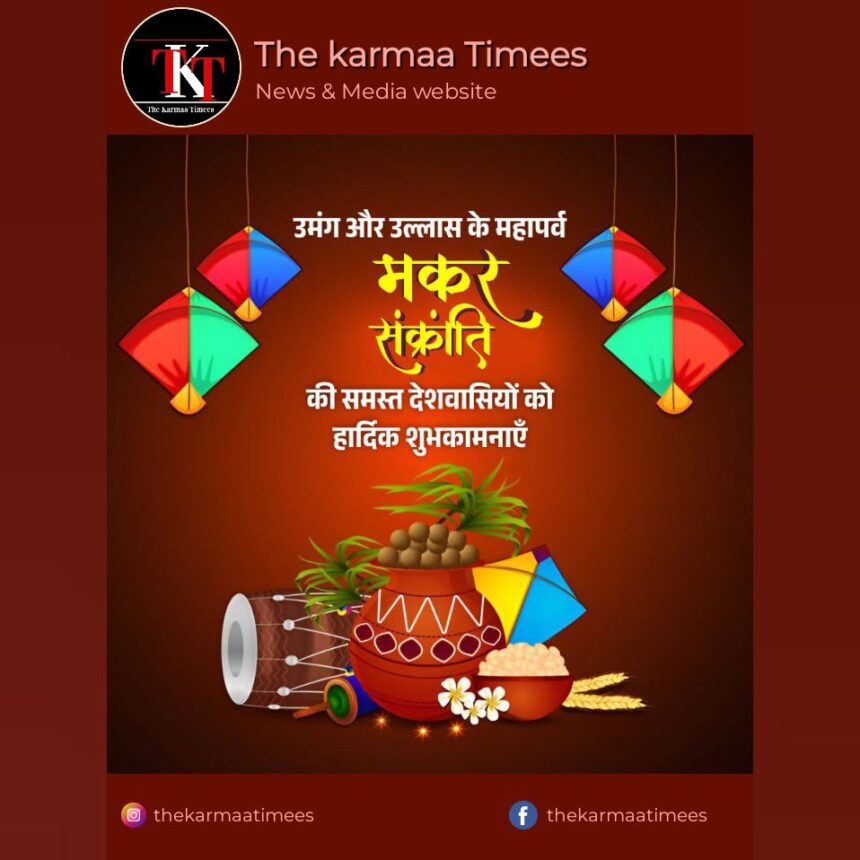Makar Sankranti: Why We Celebrate, History, Significance, and Its Impact on Daily Life
Introduction
Makar Sankranti, one of the most significant Hindu festivals, marks the transition of the Sun into the zodiac sign Capricorn (Makara) on its celestial path. Celebrated with enthusiasm and vibrancy across India, this festival holds cultural, religious, and agricultural importance. From kite flying to bonfires, It has woven itself into the fabric of Indian society, becoming more than just a date on the calendar.
Let’s delve into the why, what, and how of this auspicious occasion.
Why is Makar Sankranti Celebrated?
- Astronomical Significance:
It signifies the Sun’s movement from the Tropic of Cancer to the Tropic of Capricorn, marking longer days and the end of winter solstice. It is celebrated as a “thanksgiving” to the Sun for its energy and warmth. - Harvest Festival:
As the Rabi crops are ready for harvest, farmers express their gratitude to nature. It’s a time of abundance, celebrated as Lohri in Punjab, Pongal in Tamil Nadu, and Bhogali Bihu in Assam. - Religious Aspect:
The festival is associated with several mythological stories, such as Lord Surya visiting his son Shani and the victory of good over evil (as symbolized by the end of the demon Sankarasur).
History of Makar Sankranti
- Ancient Origins: The festival dates back to the Vedic times. The transition of the Sun is described in ancient scriptures like the Mahabharata and the Puranas.
- Cultural Diversity: Different states celebrate it with unique traditions. For instance, Uttar Pradesh sees the Ganga Snan ritual, while Gujarat becomes a hub for kite flying.
- Agricultural Roots: Historically, the festival marked the end of the harvesting season, a reason for farmers to rejoice.
Facts About Makar Sankranti
- Oldest Harvest Festival: It is one of the oldest harvest festivals still celebrated.
- Not Fixed by Lunar Calendar: Unlike most Hindu festivals, Makar Sankranti follows the solar calendar and falls on January 14th or 15th every year.
- Kite Flying Tradition: This practice is symbolic of reaching higher spiritual realms and paying homage to the Sun.
- Multiple Names: Known as Maghi, Pongal, Lohri, Uttarayan, and Khichdi depending on the region.
- Charitable Acts: Charity, especially of food and clothes, is considered auspicious.
Significance and Observance
- Spiritual Importance: Taking a dip in holy rivers like the Ganges is believed to cleanse one’s sins.
- Family Bonding: Relatives gather to celebrate with special dishes like til laddoos and khichdi.
- Unity in Diversity: The festival brings people together, transcending cultural boundaries.
Daily Life Lessons from Makar Sankranti
- Gratitude: Encourages us to thank nature and our support systems.
- Community Spirit: Promotes togetherness and sharing.
- Optimism: The festival symbolizes a fresh start, urging us to leave negativity behind.
Wishing and Greetings
Sharing heartfelt wishes on Makar Sankranti has become integral. Popular greetings include:
- “Wishing you a harvest of joy and prosperity this Makar Sankranti!”
- “May the Sun’s rays of hope and positivity brighten your life.”
Importance to Society
- Economic Boost: Kite-making, food preparations, and other activities create seasonal employment.
- Cultural Heritage: Helps in preserving traditional values and practices.
- Environmental Awareness: Many rituals emphasize harmony with nature.
FAQs
Q1: Why is sesame (til) so important on Makar Sankranti?
A: Sesame symbolizes purity and is believed to purify the body and soul.
Q2: Why does the date not change much?
A: Makar Sankranti follows the solar calendar, ensuring it aligns closely with the Sun’s movement.
Q3: Which state celebrates it as Pongal?
A: Tamil Nadu celebrates Makar Sankranti as Pongal, a four-day festival.
Key Takeaways
- It is more than a religious festival; it’s a celebration of life, gratitude, and togetherness.
- Its traditions teach us to value nature, community, and positivity.
- The festival’s relevance transcends time, continuing to unite people across cultures and regions.
List of what Makar Sankranti is called in different regions of India and the world:
Here’s a list of what Makar Sankranti is called in different regions of India and the world:
In India
- Lohri – Punjab, Haryana, Himachal Pradesh
Celebrated a day before Makar Sankranti, Lohri marks the end of winter and is associated with bonfires, dance, and harvest festivities. - Pongal – Tamil Nadu
A four-day festival thanking nature, cows, and the Sun for a bountiful harvest. - Uttarayan – Gujarat, Rajasthan
Known for vibrant kite-flying competitions and joyous celebrations. - Maghi – Punjab and Haryana
Associated with taking dips in rivers and enjoying khichdi and sweets. - Khichdi – Uttar Pradesh and Bihar
The festival is named after the traditional dish of lentils and rice prepared on this day. - Bhogali Bihu – Assam
A harvest festival where community feasts, dances, and bonfires are prominent. - Suggi or Ellu Bella – Karnataka
Farmers celebrate the harvest, and the exchange of ellu bella (a mixture of sesame, jaggery, and coconut) is significant. - Poush Sankranti – West Bengal
Marked by preparing Pitha (rice cakes) and taking holy dips in the Ganga Sagar. - Makara Vilakku – Kerala
Associated with the pilgrimage to Sabarimala and witnessing the Makara Jyoti. - Magh Bihu – Assam
A harvest festival involving feasts, dances, and gratitude for a good harvest.
In Other Parts of the World
- Nepal – Maghe Sankranti
Celebrated with feasts, including sesame sweets, yam, and molasses. - Sri Lanka – Thai Pongal
Similar to Tamil Nadu’s Pongal, it is observed with prayers and offerings. - Myanmar – Thingyan (Water Festival)
Though celebrated in April, the essence is tied to the movement of the Sun, resembling aspects of Makar Sankranti. - Thailand – Songkran
Celebrated in April, marking a solar transition, with water fights and rituals of renewal. - Cambodia – Moha Sangkran
Part of the Khmer New Year festivities, observed with traditional games and offerings. - Indonesia – Sugian Bali
Celebrated in Bali, it aligns with the solar calendar and honors nature. - Pakistan – Lohri
Observed by Punjabi communities with bonfires and folk songs. - Bangladesh – Poush Sankranti
Similar to West Bengal, it involves rituals at the Ganges delta and the preparation of sweets.
Each region, whether in India or abroad, adapts Makar Sankranti to its unique cultural and climatic context, showcasing the universal themes of gratitude, renewal, and joy.
Conclusion
It is not just a festival; it’s a reflection of India’s vibrant culture and agricultural roots. As you fly kites, savor sweet til laddoos, and enjoy the warmth of family, remember the deeper essence of this day. Celebrate the Sun, celebrate life, and make every day as bright and joyful as Makar Sankranti!










